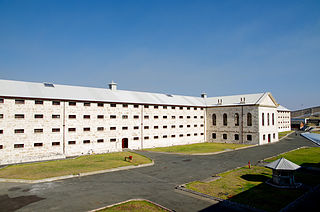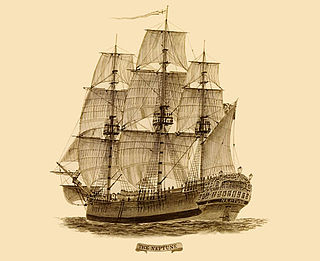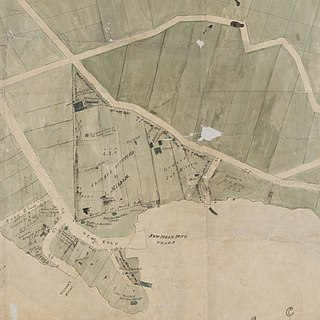
A penal colony or exile colony is a settlement used to exile prisoners and separate them from the general population by placing them in a remote location, often an island or distant colonial territory. Although the term can be used to refer to a correctional facility located in a remote location it is more commonly used to refer to communities of prisoners overseen by wardens or governors having absolute authority.

Penal transportation or transportation was the relocation of convicted criminals, or other persons regarded as undesirable, to a distant place, often a colony for a specified term; later, specifically established penal colonies became their destination. While the prisoners may have been released once the sentences were served, they generally did not have the resources to return home.

Joseph Bolitho Johns, better known as Moondyne Joe, was an English convict and Western Australia's best-known bushranger. Born into poor and relatively difficult circumstances, he became something of a petty criminal robber with a strong sense of self-determination. He is remembered as a person who had escaped multiple times from prison.

Fremantle Prison, sometimes referred to as Fremantle Gaol or Fremantle Jail, is a former Australian prison and World Heritage Site in Fremantle, Western Australia. The six-hectare (15-acre) site includes the prison cellblocks, gatehouse, perimeter walls, cottages, and tunnels. It was initially used for convicts transported from Britain, but was transferred to the colonial government in 1886 for use for locally-sentenced prisoners. Royal Commissions were held in 1898 and 1911, and instigated some reform to the prison system, but significant changes did not begin until the 1960s. The government department in charge of the prison underwent several reorganisations in the 1970s and 1980s, but the culture of Fremantle Prison was resistant to change. Growing prisoner discontent culminated in a 1988 riot with guards taken hostage, and a fire that caused $1.8 million worth of damage. The prison closed in 1991, replaced by the new maximum-security Casuarina Prison.
Convict assignment was the practice used in many penal colonies of assigning convicts to work for private individuals. Contemporary abolitionists characterised the practice as virtual slavery, and some, but by no means all, latter-day historians have agreed with this assessment.
The Parkhurst apprentices, juveniles from a reformatory attached to Parkhurst Prison on the Isle of Wight, were sentenced to "transportation beyond the seas" and transported to Australia and New Zealand between 1842 and 1852. Either before leaving England or on arrival at their destination, they were pardoned on the conditions that they be "apprenticed" to local employers, and that they not return to England during the term of their sentence. In the ten years between 1842 and 1852 nearly 1500 boys aged from twelve to eighteen were transported to Australia and New Zealand from Parkhurst Prison.

The convict era of Western Australia was the period during which Western Australia was a penal colony of the British Empire. Although it received small numbers of juvenile offenders from 1842, it was not formally constituted as a penal colony until 1849. Between 1850 and 1868, 9,721 convicts were transported to Western Australia on 43 convict ship voyages. Transportation ceased in 1868, but it was many years until the colony ceased to have any convicts in its care.
HMP Isle of Wight – Parkhurst Barracks is a prison situated in Parkhurst on the Isle of Wight, operated by Her Majesty's Prison Service.
Following Western Australia's convict era, 37 ex-convicts were appointed school teachers in the colony. The appointment of such a large number of ex-convicts to what was considered a respectable government position was highly unusual for a penal colony, as the social stigma of conviction usually excluded ex-convicts from such positions.

Between 1788 and 1868, about 162,000 convicts were transported from Britain and Ireland to various penal colonies in Australia.

Hougoumont was the last convict ship to transport convicts to Australia.
Scindian is widely considered the first convict ship to transport convicts to Western Australia.
Simon Taylor was a barque built in 1824 on the River Thames that transported assisted migrants to Western Australia.

A convict ship was any ship engaged on a voyage to carry convicted felons under sentence of penal transportation from their place of conviction to their place of exile.
Convict women in Australia were British prisoners whom the government increasingly sent out during the era of transportation (1787-1868) in order to develop the penal outpost of New South Wales into a viable colony.

Surry, also known as Surrey, had an especially long career transporting convicts to Australia. In 11 voyages, the most of any convict transport, she brought 2,177 convicts, male and female, and so became one of the best-known of the vessels that visited Australia. In all, she lost 51 men and one woman during her various passages, 46 of the men dying during her first and most notorious voyage in 1814 when she was under the command of James Patterson. The high death toll on her first voyage led to a Board of Enquiry, which blamed neglect by the Master and Surgeon.
Joseph Backler was an English-born Australian painter. Transported to Australia as a convict in 1832, he obtained a ticket of leave in 1842 and was active as a painter from 1842 to 1880.
Norfolk Island twice served as a penal colony, from March 1788 to February 1814, and from 1825 to 1853. During both periods the government in the Colony of New South Wales transferred convicts that had been brought to Australia on to the island.
Several vessels have been named Cumberland for the county of Cumberland:
Lady Kennaway was launched in Calcutta in 1816. In 1819 and thereafter she sailed between England and India under a license from the British East India Company (EIC). In 1823 she was sold in London. She made three voyages under charter to the EIC. In 1835 and again in 1851 she made voyages transporting convicts to Tasmania. On one voyage some of the convicts were young men for the Pankhurst apprentice scheme. In between, in 1836, she transported convicts to New South Wales. She made five voyages carrying immigrants to Australia, including young Irish women for the Earl Grey Irish Famine Orphan scheme. In 1847 her crew abandoned her in the Bay of Biscay although she seemed to have sustained little damage; she was salvaged and returned to service. She was finally wrecked on 25 November 1857 at South Africa.









